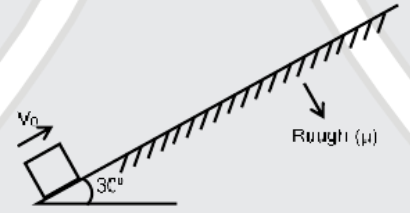A block starts moving up a fixed inclined plane of inclination 60∘C with a velocityof 20ms−1 and stops after 2s. The approximate value of the coefficient of friction is [g=10ms−2]
3
3.3
0.27
0.33
The correct Answer is:C
To solve the problem, we need to analyze the motion of the block on the inclined plane and apply the equations of motion along with the forces acting on the block. Here’s a step-by-step solution:
Step 1: Identify the given data
- Inclination angle, θ = 60°
- Initial velocity, u = 20 m/s
- Final velocity, v = 0 m/s (the block stops)
- Time, t = 2 s
- Acceleration due to gravity, g = 10 m/s²
Step 2: Calculate the acceleration of the block
Using the equation of motion:
v=u+at
Substituting the known values:
0=20+a⋅2
Solving for acceleration (a):
a=−202=−10m/s2
Step 3: Analyze the forces acting on the block
The forces acting on the block include:
1. Gravitational force (mg)
- Component parallel to the incline: mgsin(60°)=mg⋅√32
- Component perpendicular to the incline: mgcos(60°)=mg⋅12
2. Normal force (N) acting perpendicular to the incline.
3. Frictional force (f) acting down the incline, which can be expressed as:
f=μN=μmgcos(60°)=μmg⋅12
Step 4: Write the equation of motion along the incline
The net acceleration of the block can be expressed as:
a=−gsin(60°)−μmgcos(60°)m
Substituting the values:
−10=−10⋅√32−μ⋅10⋅12
Step 5: Simplify and solve for the coefficient of friction (μ)
Rearranging the equation:
−10=−5√3−5μ
5μ=−10+5√3
μ=−10+5√35
μ=−2+√3
Step 6: Calculate the approximate value of μ
Using the approximate value of √3≈1.732:
μ≈−2+1.732
μ≈−0.268
Since we are looking for the approximate value, we can round this to:
μ≈0.27
Conclusion
The approximate value of the coefficient of friction is:
μ≈0.27
---
- Inclination angle, θ = 60°
- Initial velocity, u = 20 m/s
- Final velocity, v = 0 m/s (the block stops)
- Time, t = 2 s
- Acceleration due to gravity, g = 10 m/s²
Using the equation of motion:
v=u+at
Substituting the known values:
0=20+a⋅2
Solving for acceleration (a):
a=−202=−10m/s2
The forces acting on the block include:
1. Gravitational force (mg)
- Component parallel to the incline: mgsin(60°)=mg⋅√32
- Component perpendicular to the incline: mgcos(60°)=mg⋅12
2. Normal force (N) acting perpendicular to the incline.
3. Frictional force (f) acting down the incline, which can be expressed as:
f=μN=μmgcos(60°)=μmg⋅12
The net acceleration of the block can be expressed as:
a=−gsin(60°)−μmgcos(60°)m
Substituting the values:
−10=−10⋅√32−μ⋅10⋅12
Rearranging the equation:
−10=−5√3−5μ
5μ=−10+5√3
μ=−10+5√35
μ=−2+√3
Using the approximate value of √3≈1.732:
μ≈−2+1.732
μ≈−0.268
μ≈0.27
The approximate value of the coefficient of friction is:
μ≈0.27
Similar Questions
A block starts moving up an inclined plane of inclination 30∘ with an initial velocity of v0 . It comes back to its initial position with velocity v02 . The value of the coefficient of kinetic friction between the block and the inclined plane is close to I1000 , The nearest integer to I is ____________ .
View SolutionA block slides down on inclined plane (angle of inclination 60∘ ) with an accelration g/2 Find the coefficient friction
 View Solution
View SolutionA ball is projected from the bottom of an inclined plane of inclination 30∘, with a velocity of 30ms−1, at an angle of 30∘ with the inclined plane. If g=10ms−2 , then the range of the ball on given inclined plane is
View SolutionA block of mass 2kg lying on ice when given a velocity of 6ms−1 is stopped by friction in 5s. The coefficient of friction between the block and ice is (g=10 ms−2)
View SolutionA body of mass 100g is sliding on a inclined plane with an inclination of 60∘. What is the frictional force experienced, if coeficient of friction is 1.7? (Take g=10m/s2)
View SolutionA block starts going up a rough inclined plane with velocity V0 as shown in figure.After some time reaches to starting point again, with a velocity V02.Find coefficient of friction μ .Given g=10msec2.
 View Solution
View SolutionA cubical block (of side 2m) of mass 20kg slides on inclined plane lubricated with the oil of viscosity η=10−1 with constant velocity of 10ms−1. Find out the thickness of the layer of liquid (take g=10ms−2).
 View Solution
View SolutionA particle of mass 0.2 kg has an intial speed of 5ms−1 at the bottom of a rough inclined plane of inclination 30∘ and vertical height 0.5 m . What is the speed of the particle as it reaches the top of the inclined plan ? (Take μ=1/√3,g=10ms−2 ) .
View SolutionA particle is fired horizontally form an inclined plane of inclination 30∘ with horizontal with speed 50ms−1. If g=10ms−2 , the range measured along the incline is
View SolutionA solid sphere is projected up along an inclined plank of inclination θ=30∘ with a speed v=2ms−1. If it rolls without slipping find the maximum distance traversed by it (g=10ms−2)
View Solution

